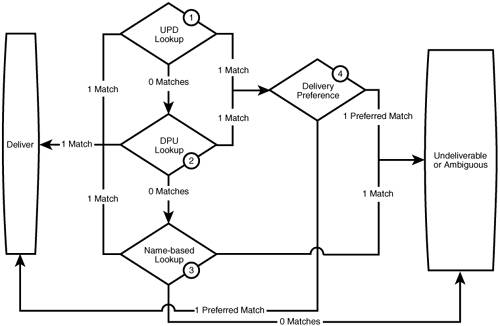Mail Routing with Internet Addressing Enabled
| Now that you understand the concepts behind GroupWise Internet addressing, this section discusses the flow of email through an Internet addressingenabled GroupWise system. Outbound EmailInternet addressingaware (or IA-aware) clients (GroupWise 5.5x and newer clients) allow mail with Internet addresses to be routed internally or to Internet users without the use of addressing rules or external domain definitions. Without Internet addressing enabled (and no addressing rules in use), messages sent to users with Internet-style addresses are flagged as undeliverable when mail is sent from the client. With Internet addressing enabled, the client performs less lookup on recipient addresses. Messages with Internet-style addresses are pushed on by the client to be resolved by the POA, MTA, or GWIA. Note, though, that each component in an IA-aware GroupWise system is capable of parsing Internet address information to some extent, including the GroupWise client. Each component (client, POA, MTA, and GWIA) will do the best it can to resolve the address from its perspective. If the POA cannot resolve an address, it pushes the message to the domain MTA. If the message is addressed to an Internet address, and the domain MTA cannot resolve the message to one of its post offices or an address internal to the system, the message will be routed to the default routing domain for a GWMTP lookup by the MTA there (you can find more on GWMTP in Chapter 34). If the recipient address cannot be resolved with a GWMTP DNS lookup, the message will be routed to the default GWIA for transfer to the Internet. Inbound EmailWhen a message arrives at a GroupWise system from the outside world, it does so in one of two ways:
Note Messages can also come in through another GroupWise gateway, but typically those are not going to be outside-world messages. Most other gateways, such as the Exchange gateway or the Lotus Notes gateway, are handing explicitly addressed messages to the GroupWise MTA, so the messages can be treated as internal to the GroupWise system. When a message comes in via GWMTP, the MTA receiving the message will process the message by sending it to the GroupWise domain within the GroupWise system of which the recipient is a member. The recipient's domain routes the message to the recipient's POA, which delivers the message to the recipient's mailbox. When a message comes in through the GWIA, via SMTP/MIME, it is processed with the flow described in Figure 16.9. The GWIA checks the domain portion of the recipient address for user alias, post office alias, foreign ID, or Internet domain name matches. If GWIA does not find a match for the recipient domain address, it will route or relay the message to an appropriate Internet mail host for the specified domain, or it will send an undeliverable message back to the sender. Figure 16.9. An example of the parsing and lookup process Assuming that a match was found (that is, the message must be delivered to this GroupWise system), the second level of resolutions involves checking the username portion of the recipient mail address to determine whether a unique match can be found. Note The GWIA is fully backward compatible for resolving traditional GroupWise addressing, in addition to using the flexible rules of Internet addressing resolution. This section explores this address resolution process in more detail. Following is the logic that the GWIA uses in routing in-bound Internet email:
The process that the GWIA uses to get a message to a recipient is quite complex. The flexibility that GroupWise gives you for defining a user's address format is what makes the process so complex. |
EAN: 2147483647
Pages: 320
- Structures, Processes and Relational Mechanisms for IT Governance
- Measuring and Managing E-Business Initiatives Through the Balanced Scorecard
- Technical Issues Related to IT Governance Tactics: Product Metrics, Measurements and Process Control
- Governing Information Technology Through COBIT
- The Evolution of IT Governance at NB Power